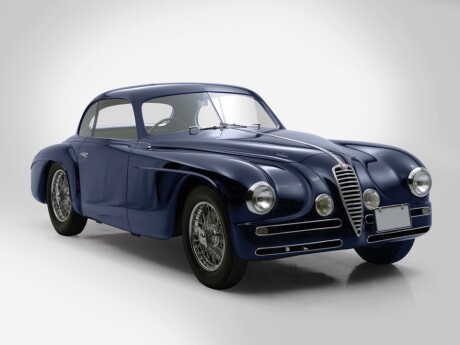
#AlfaRomeo6C2500SSVillaDEste
For Alfa Romeo, the 6C 2500 was the swansong of its era. When it debuted in 1939 as the third series of Vittorio Jano's legendary inline six-cylinder Alfas, the engineers involved could never have imagined that it would signal the end of the line for hand-built Alfa Romeos.<br / >Thanks to engine upgrades and a vastly improved fuel delivery system, the 6C 2500 was the first road going Alfa Romeo capable of 160 km/h. Additionally, it benefited from four-wheel independent suspension, with parallel trailing arms and coil springs in the front and swing axles with torsion bars at the rear. Alfa Romeo continued its tradition of offering several levels of tuning, starting with the 87-horsepower Turismo, moving up to the 110-horsepower Super Sport, or SS, and culminating in the track-ready Tipo 256 with 120 horsepower. The 6C 2500 was immediately met with praise and success from its hand-selected upscale clientele. Alfa Romeo was, of course, still in the business of providing rolling chassis to custom coachbuilders, even as the onset of war loomed. The first project created after war's end was the factory-offered 6C 2500 Freccia d'Oro, which had essentially the same running gear as the pre-war 6C 2500s. <br / >In the post-war years the demand for bespoke coachworks was very high and probably more than fifteen Italian coachbuilders built special bodies to clothe the important Alfa Romeo 6C 2500 chassis; of course, Carrozzeria Touring was one of them.
Three years later, in 1949, Alfa Romeo introduced the Villa d'Este Berlinetta Coupés with Superleggera coachwork by Touring, of Milan. Alfa Romeo chose the name Villa d'Este after this design won the Concours d'Elegance, which was held at the historic resort on Lake Como in northern Italy. The Touring-bodied 1949 6C 2500 Super Sport that enthralled the crowds in 1949 won the Gran Premio Referendum, also known as the People's Choice Award. Between 1949 and 1952, a mere thirty-one Villa d'Este Coupés were produced, not including an additional five cabriolets. The 6C 2500's production ended in 1952 (a couple of racing examples were produced in 1953), representing the end of hand-built Alfa Romeos.
We'll tell the story of this model on the occasion of its anniversary or when it will reach a sufficient number of cars.
If you would like to share your knowledge and archive, click on the banner JOIN THE LAB - HELP US TO IMPROVE & COMPLETE THE INFORMATION.
The census of all the cars related to this topic is in progress.
CARS (1)
